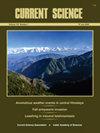Calcite polymorphs in historic plasters of India’s arid region – execution technique, composition and characterization
IF 1
4区 综合性期刊
Q3 MULTIDISCIPLINARY SCIENCES
引用次数: 1
Abstract
: The lime works in India’s desert region were executed by a technique that is characteristically different from other parts of the country. The area is very hot and the high evaporation of water due to heat and less rain has caused salinity to the groundwater. Due to local climatic conditions, the decorative works of Rajasthan were executed on a shiny white plaster by a technique locally named Ala-Gila which is sometimes compared with the true fresco of Italy. The Persian colonial arts also flourished in this part and the color palette suddenly changed from vibrant to more shiny colors in the paintings. In this work, the microscopic observation of thin section was utilized to investigate geological and fine morphological features of the 16th century Amber fort lime plaster-a WHS site and a very popular tourist destination. The FTIR, XRD, and SEM photomicrographs of the plasters showed the stabilization of different crystalline phases of polymorphs of calcium carbonate. The chemical analysis and SEM-EDX data denote dolomitic limestone probably sourced for plaster works. The high amount of magnesium present in the raw material, the environmental conditions at the time of the application of the plaster, pH, etc. have stabilized calcite polymorphs in the plaster. The calcite meta-stable phases have undergone dissolution with time making the plaster weak. This has increased porosity, permeability, and resultant lowering of plaster's mechanical strength. The thermal analysis and cementation index of the plaster showed the use of non-hydraulic binder-rich air-lime for plaster works. The granulometric study showed the mixing of reddish-brown sand-size grains, and the aggregates were probably from the same location for major construction activity. The low proportion of aggregates led to reduced mechanical strength, and the is vulnerable to damage. It is to a major restoration of the ancient lime works with compatible materials as per analytical data印度干旱地区历史石膏中方解石的多形物——制作技术、成分和特征
印度沙漠地区的石灰工程采用了一种与该国其他地区截然不同的技术。该地区非常炎热,由于高温和少雨,水的高度蒸发导致地下水含盐量高。由于当地的气候条件,拉贾斯坦邦的装饰作品是用一种当地称为Ala-Gila的技术在闪亮的白色石膏上完成的,这种技术有时会与意大利的真正壁画相比较。波斯殖民艺术也在这一地区蓬勃发展,绘画中的调色板突然从充满活力的颜色变成了更闪亮的颜色。本研究利用薄切片显微观察的方法,研究了16世纪琥珀堡石灰灰泥的地质和精细形态特征。琥珀堡石灰灰泥是世界文物保护遗址,也是一个非常受欢迎的旅游目的地。石膏的FTIR, XRD和SEM显微照片显示了碳酸钙多晶体的不同晶相的稳定性。化学分析和SEM-EDX数据显示白云岩可能来源于石膏工程。原料中镁的含量高,石膏应用时的环境条件,pH值等都稳定了石膏中方解石的多晶态。方解石的亚稳定相随着时间的推移发生溶解,使石膏变弱。这增加了孔隙度和渗透性,从而降低了石膏的机械强度。石膏的热分析和胶结指标表明,非水力富粘结剂气石灰可用于石膏工程。粒度研究表明,混合了红褐色砂粒大小的颗粒,并且聚集体可能来自同一地点的主要建筑活动。骨料比例过低导致混凝土的机械强度降低,易发生损伤。根据分析数据,这是对古代石灰工程的重大修复,使用兼容的材料
本文章由计算机程序翻译,如有差异,请以英文原文为准。
求助全文
约1分钟内获得全文
求助全文
来源期刊

Current Science
综合性期刊-综合性期刊
CiteScore
1.50
自引率
10.00%
发文量
97
审稿时长
3 months
期刊介绍:
Current Science, published every fortnight by the Association, in collaboration with the Indian Academy of Sciences, is the leading interdisciplinary science journal from India. It was started in 1932 by the then stalwarts of Indian science such as CV Raman, Birbal Sahni, Meghnad Saha, Martin Foster and S.S. Bhatnagar. In 2011, the journal completed one hundred volumes. The journal is intended as a medium for communication and discussion of important issues that concern science and scientific activities. Besides full length research articles and shorter research communications, the journal publishes review articles, scientific correspondence and commentaries, news and views, comments on recently published research papers, opinions on scientific activity, articles on universities, Indian laboratories and institutions, interviews with scientists, personal information, book reviews, etc. It is also a forum to discuss issues and problems faced by science and scientists and an effective medium of interaction among scientists in the country and abroad. Current Science is read by a large community of scientists and the circulation has been continuously going up.
Current Science publishes special sections on diverse and topical themes of interest and this has served as a platform for the scientific fraternity to get their work acknowledged and highlighted. Some of the special sections that have been well received in the recent past include remote sensing, waves and symmetry, seismology in India, nanomaterials, AIDS, Alzheimer''s disease, molecular biology of ageing, cancer, cardiovascular diseases, Indian monsoon, water, transport, and mountain weather forecasting in India, to name a few. Contributions to these special issues ‘which receive widespread attention’ are from leading scientists in India and abroad.
 求助内容:
求助内容: 应助结果提醒方式:
应助结果提醒方式:


